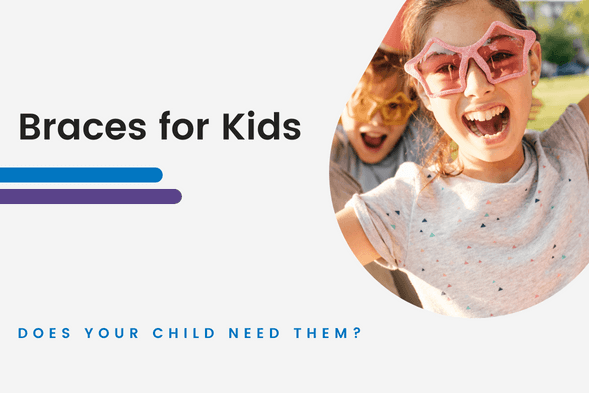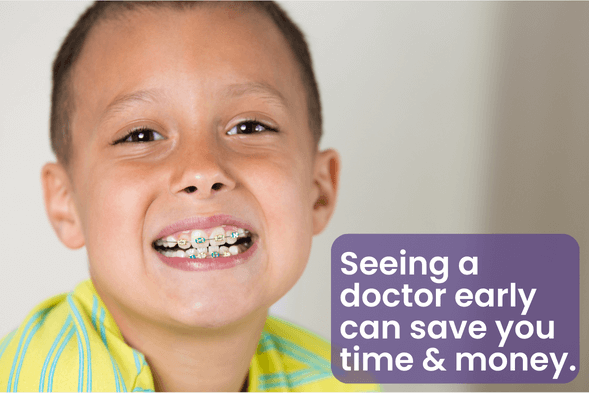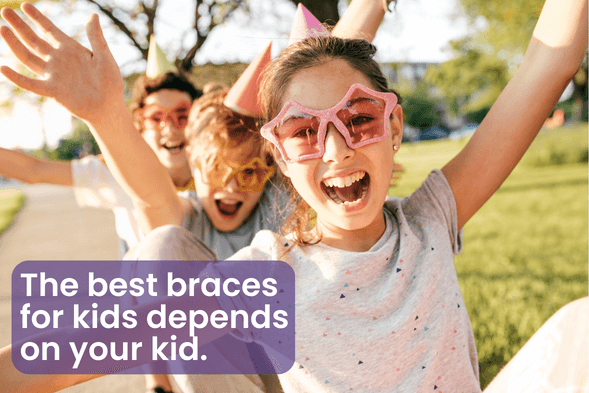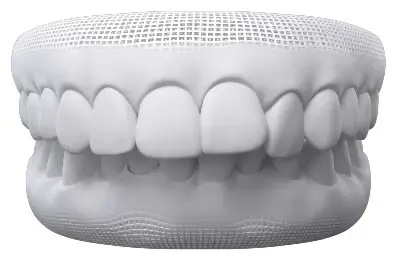
Dear parents, if you’re wondering whether your child needs braces and where you should get braces for kids in Phoenix, you’ve come to the right place.
We want to help shed light for you on all things related to braces for kids. In this post, you’ll get the common reasons why children may benefit from braces, what the right age for braces treatment is, the cost of braces in Phoenix, and a whole lot more that will help you make an informed decision about your child’s dental health.
So sit back, and we’ll unravel what you need to know about the most common way to straighten teeth.
Why Do Kids Need Braces?
There are many different reasons why children may need braces, which are orthodontic devices used to correct teeth alignment and bite issues. Here are some common reasons:
- Crooked teeth: One of the primary reasons for braces is to address crooked or misaligned teeth. Crooked teeth can occur due to various factors, including genetics, thumb sucking, early loss of baby teeth, or improper dental development.
- Overcrowding: When there is insufficient space in the mouth to accommodate all the teeth, overcrowding occurs. This can lead to teeth shifting or becoming twisted. Braces can help create space and align the teeth properly.
- Malocclusion: Malocclusion refers to an abnormal bite, where the upper and lower teeth do not fit together correctly. Examples of malocclusion include overbite (upper teeth protrude), underbite (lower teeth protrude), and crossbite (teeth are misaligned laterally). Braces can help correct these bite issues.
- Jaw misalignment: Braces are sometimes used to address jaw misalignment, such as an over- or underdeveloped upper or lower jaw. By guiding the growth of the jaw and aligning the teeth, braces can improve both aesthetics and functionality.
- Correcting habits: Certain habits like thumb sucking, tongue thrusting, or prolonged pacifier use can cause dental issues and contribute to misalignment. Braces can help correct these problems and promote proper oral habits.
It’s important to note that every child’s orthodontic needs are unique, and the decision to get braces should be made in consultation with an orthodontist and your pediatric dentist. They can evaluate the specific dental condition and recommend the most appropriate treatment options.
What’s the Right Age for Braces?
It can be confusing to know exactly when the right time is for your child to see an orthodontist about getting braces. You might be surprised to find out that the best answer for your child’s smile and your wallet is often early treatment.

Here are the key facts about the right age for braces.
At what age can children have orthodontic treatment?
The American Association of Orthodontists recommends that children see an orthodontist no later than age 7. Orthodontic treatment is not usually required at this time for many children, but seeing an orthodontist at an early age can provide you with valuable information about the right age to seek orthodontic care for your children.
Here are some of the biggest reasons why age 7 is the best time to see an orthodontist and get x-rays:
Baby Teeth vs. Permanent Teeth
Believe it or not, it’s actually best if your child still has some baby teeth for their first orthodontist appointment. By age 7, most children have enough adult teeth in their mouth while still having some baby teeth for the orthodontist to examine as well.
Tooth Decay and Other Hidden Issues are Easier to Catch
If a problem exists or is beginning to develop with jaw growth or emerging adult teeth, your orthodontist can catch it here and advise you on when to begin treatment.
Treatment isn’t always necessary immediately. But you’ll be sure to give your child the best chance at a healthy smile and avoiding alignment problems later in life. It’ll also give you the best chance of avoiding more expensive treatment later.
When should kids get braces?
There is no single one right answer for when kids should get braces. When your child should wear braces depends on their unique needs, tooth position, alignment problems, and well-being.
The age a child qualifies for orthodontic braces varies from case to case.
Best Age for Braces
Get a free consultation at Dickerson Orthodontics and we’ll help you know what the best age for braces might be for your child. You’ll walk away with the peace of mind and confidence of knowing exactly how everything with their smile is developing and if you should start treatment early.
(Read More: How Old Do You Have to be to Get Braces?)
Types of Braces
Traditional Metal Braces
Traditional metal braces are the type of braces that have been around for decades and remains one of the most commonly used methods to straighten teeth. These braces consist of small metal brackets bonded to the front of your child’s teeth. A thin wire is then threaded through the brackets and held in place by elastic bands.
Over time, the tension from the wire exerts gentle pressure on the teeth, gradually moving them into their desired positions. Although they may seem a bit conspicuous, wearing braces is highly effective and can correct a wide range of dental issues, including crooked teeth, overcrowding, and bite misalignments.
Additionally, they offer the benefit of being durable and efficient. Historically more patients have also been able to afford braces compared to other orthodontic options (although that is changing).
Ceramic (clear and tooth-colored)
Ceramic braces, also known by their popular name ‘clear braces’, are a popular alternative to traditional braces. They offer a more discreet treatment option.
Similar in design to metal braces, ceramic braces utilize the same technology as their more traditional relative to gradually align the teeth.
What sets them apart is that the brackets are made from either a clear or tooth-colored ceramic material, blending in much more with the natural color of your teeth. This makes ceramic braces much less noticeable compared to their metal counterparts.
With ceramic, it is easier to damage braces and they may require a bit more care to prevent staining or discoloration. But like traditional braces, ceramic braces offer a reliable and effective solution for correcting various dental issues.
Damon Braces
Damon Braces straighten teeth similarly to traditional and ceramic braces but use proprietary technology to reduce friction, improve oral hygiene and eliminate elastic ties.
Here’s the technology behind the Damon System in their own words:
The Damon System utilizes a patented slide mechanism to connect archwires to the bracket while allowing the wire to move freely. The Damon System reduces friction and improves oral hygiene by eliminating elastic ties.
While we are certified in the Damon System and proud to be, we’ll also readily advise you that sometimes there are better options for your unique case than Damon Braces.
Clear Damon braces in particular have some drawbacks that it’s important you know about in advance. While they are more discreet, they’re also more likely to break and can make your treatment take a little longer.
Colored Braces
Unlike traditional braces that use clear or silver ligatures to hold the archwire in place, colored braces allow individuals to choose from a wide range of colorful elastic ties.
These ties are placed around each bracket, adding a playful and personalized touch to your child’s braces. Colored braces offer a way to express one’s personality or showcase a favorite color.
They have recently grown in popularity among children, teenagers, and patients who enjoy embracing their individuality.
While traditional braces offer a more subtle appearance, colored braces provide a creative and eye-catching option for those looking to make a statement with their treatment plan.
Lingual Braces
Lingual braces are a type of braces where the brackets and wires are placed on the backside of the teeth, making them virtually invisible from the front.
They offer a discreet alternative to traditional braces for individuals who desire a more aesthetically pleasing option. Lingual braces are custom-made to fit each individual’s teeth and can effectively address various dental issues while maintaining a natural-looking smile.

What Happens When We Visit an Orthodontist?
While most orthodontist visits feel very similar to an appointment at your dentist office, every orthodontic office has their own approach. Here are some key things to watch out for:
- Many orthodontists charge for your initial consultation. At Dickerson Orthodontics, your initial consultation is free.
- Some offices offer virtual consultations and others do not. At Dickerson Orthodontics we find that most of our patients prefer in-person consultations, and that’s how you’ll get the most personalized treatment plans too.
- Some doctors still have hidden fees in their orthodontic services. At Dickerson Orthodontics, we don’t believe in hidden fees so we don’t have them. The price you see is the one you’ll pay for treatment.
- Depending on the office, you may be left to financially cover braces on your own. At Dickerson Orthodontics, we accept dental insurance plans and also have flexible payment plans to help you with cost.
During your appointment, we will help you understand the best options for your child and even coordinate with their pediatric dentist if need be to make sure we’re giving the best possible advice.
How Long Will My Child Be Wearing Braces?
How long your child will be wearing braces completely depends upon their unique case and which orthodontist in Phoenix you choose. Today, the average treatment time for braces worn in the United States is 22-24 months.
However, at Dickerson Orthodontics, most of our patients finish braces and Invisalign in half that time – 2x faster than average. If you want to reduce the treatment time for your child’s braces, get a free consultation today and we’ll help.
Keeping your teeth clean with braces can be a challenge. That said, we’ll help you understand certain foods to avoid and the tips and tricks to great oral hygiene.
How much do braces cost for kids?
While the cost of braces varies from child to child depending on your case and dental insurance coverage, quality braces treatment in the United States typically will cost you about $6,000 – $7,000.
Braces cost for kids is not necessarily any cheaper than it is for adults, but it can help you to avoid greater costs later in life. For everything you need to know about the cost of braces, read our Ultimate Guide to Braces Cost.

Best Pediatric Orthodontist Near Me in Phoenix, Arizona for Your Child’s Teeth
The best pediatric orthodontist is the one that can help your child wear braces for the shortest amount of time and do the most to help their permanent teeth develop smoothly.
Why is short treatment so important? Especially for children, the more time you wear braces, the greater chances of tooth decay, decreased oral hygiene, and mouth issues.
Many orthodontists will give you a very similar estimate for treatment time and that’s why finding an orthodontist who can do better is such an advantage.
At Dickerson Orthodontics, we give you that advantage. Our patients finish braces or Invisalign up to 2x faster than average at other doctors in Phoenix and elsewhere in the United States.
Avoid forcing your child to wear braces longer than necessary and get affordable braces with Dickerson Orthodontics today.
Conclusion – Braces for Kids
Now you know how to prioritize your child and their longterm health when it comes to braces.
If you’re looking for braces for kids in Phoenix, Peoria, Scottsdale, or Chandler, be sure to visit and take advantage of our free consultation and find out how you can also enjoy other huge benefits like:
- finishing braces 2x faster than at other orthodontists
- saving time with fewer appointments
- enjoying 1-on-1 care from a world-leading orthodontist near you


